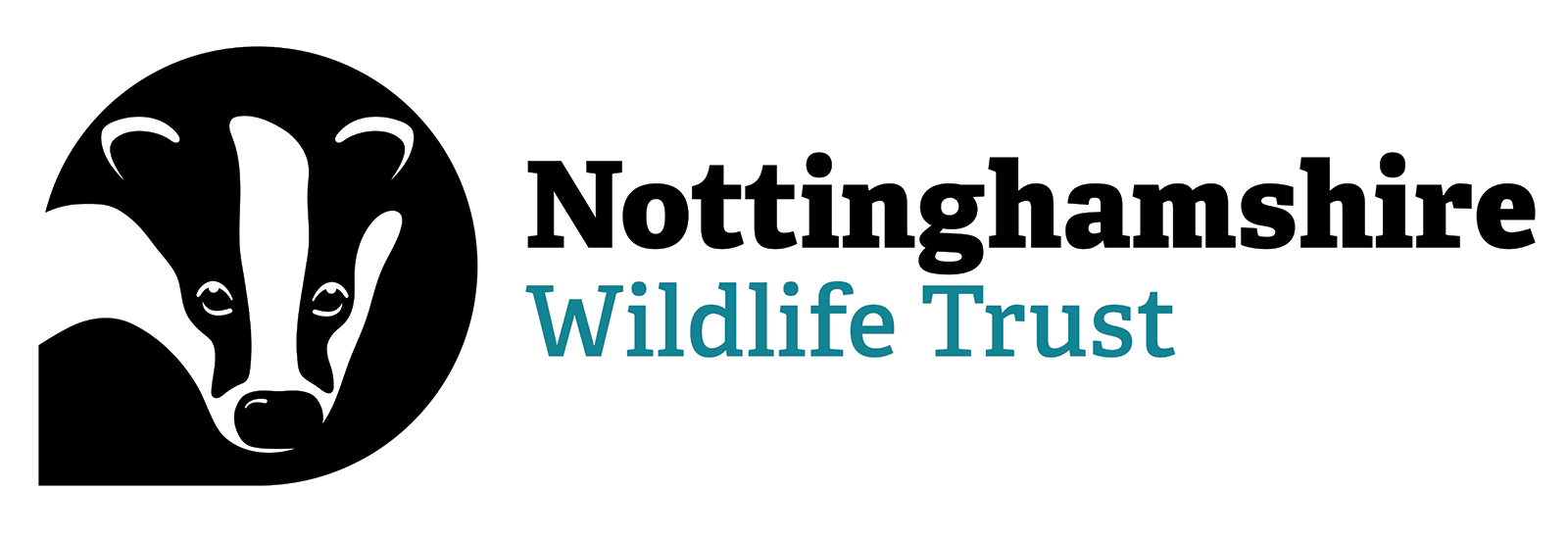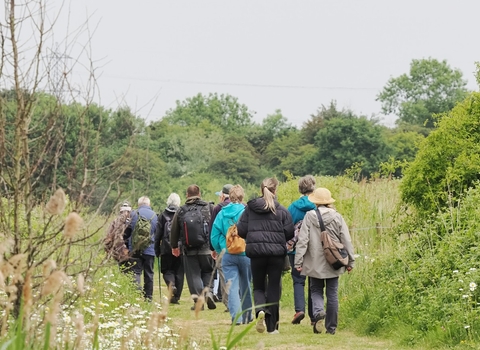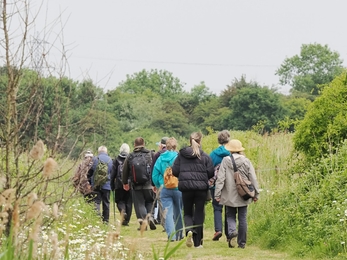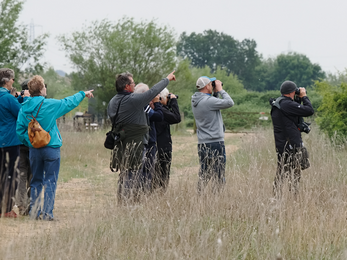People & wildlife thriving together
As part of the project, the Trust is giving people opportunities to get out into nature with guided nature walks and volunteering programmes, so that people and nature can thrive together.
28th September 2025 - World Rivers Day Walk
On Sunday 28th September, 20 people joined in celebrating World Rivers Day by walking from Nottingham City Centre to Attenborough Nature Reserve along the Notts/Beeston Canal and River Trent.
The Thriving in a Wilder Trent project team took the opportunity to showcase some of the project delivery along the way - including the floating eco-system on the canal that has been installed by Canal Rivers Trust, control methods employed to control Pennywort and Himalayan Balsam on our waterways, project delivery on sites either side of the river at Skylarks, Holme Pit, Iremongers and Attenborough; there was also the opportunity to talk about the NoFence collars worn by cattle and the benefits that is having on the Trust's sites, and the 5 tern rafts that have been installed across 5 different locations in Nottinghamshire, which have all supported nesting birds this season.
The project, funded by DEFRA via Species Survival Fund grant, is due to conclude at the end of the year. Representatives from Nottinghamshire and Derbyshire Wildlife Trusts were on hand to answer questions and lead people along the 8-mile route to a well-earned buffet lunch at Attenborough Nature Reserve.
Some lovely feedback:
"It was interesting and motivating to see some of the works undertaken during the project and also gave ideas for small improvements that we can make elsewhere."
"Just a lovely thing to do, a nice group of people, good to chat with different people along the way, informative and interesting. Really good to meet NWT staff and hear about the NWT's current projects, partnerships and plans (including the storks and NTU water testing project)."
"Something different and very enjoyable."
"Thank you for the wonderful opportunity to learn about the work that is being done. It was an enjoyable walk that I hope you will organise again next year."
12th-18th May 2025 - Mental Health Awareness Week
In recognition of Mental Health Awareness Week, the Trust arranged a riverside well-being walk at Farndon as part of the Thriving in a Wilder Trent project. The walk focused on the importance of taking a break from the hectic world we live in and how nature can support in doing this. The day started with breathing exercises and alerting the senses to the natural world around them, mindful walking along the riverbank - using stimulus cards to focus the senses on flowers, plants, insects and birds, Qi Gong exercises aligning breathing with gentle movements and a nature journalling exercise to explore the importance of nature in our day to day lives.
The weather was very kind and we enjoyed a picnic lunch at Farndon Ponds Nature Reserve in the spring sunshine. A tranquil break from the hustle and bustle of daily life, with no mobile phone interruptions and dedicated time to relax and enjoy a peaceful natural world. When asked how people felt at the end of the walk, one replied, "happy and relaxed" and another said, "I feel so relaxed - like wet spaghetti"
18th May 2025 - RSPB Langford Lowfields
On 18th May, RSPB held a guided walk at the Langford Lowfields site. Joe Harris, RSPB Site Manager stated,
"12 people attended the guided walk at Langford Lowfields and we saw and heard a good range of wildlife including Great White Egrets, Bitterns, Hobbies, Marsh Harrier, Red Kite, Cuckoos, Peregrine Falcon and Roe Deer. In fact, we saw a grand total of 60 species of birds. We also saw the wonderous new SSF-funded polytunnel and I talked about the up-coming reed translocation scheduled for August."
Himalayan balsam
Himalayan balsam is a plant native to western and central Himalayas. It was brought to the UK in 1839, due to its beautiful flowers and striking leaves and stem. However, like many plant species brought across it soon escaped and has since been causing many problems for our native species.
As part of the project, we delivered various 'balsam-bashing' projects across sites.
These included:
21st May - Netherfield Lagoons
18th June - Netherfield Lagoons
2nd July - Iremongers Pond
16th July - Netherfield Lagoons
11+12 July - Attenborough
30th July - Netherfield Lagoons
Community groups, businesses and individuals signed up via our Events page to take part.
We have also compiled this useful toolkit for identifying and safely removing the plant:
How to: pull Himalayan balsam (https://www.youtube.com/watch?v=l_GgcaHYeRE)
Join Miriam, our Wilder Trent Project Officer as she guides you in how to pull the invasive Himalayan balsam plant correctly and safely.
Besthorpe Cream Tea and guided walk 5th July
Villagers at Besthopre invited us to join their cream tea and we provided an update on the project highlighting the upcoming work due at Besthorpe Nature Reserve and along the River.
We also invited them to a guided walk at Besthorpe Nature Reserve to showcase the reserve and the current work through the project including the new tern platform. 25 people joined us on the walk.
11-12 July 2025 - Big Balsam Bash at Attenborough Nature Reserve
We undertook a Big Balsam Bash at Attenborough Nature Reserve on 11th and 12th July 2025 - in the scorching heat with lots of enthusiastic volunteers we blasted our way through shaded portions of the reserve, helping to reduce the amount of this pesky non native species on our site.
Big Balsam Bash at Attenborough Nature Reserve (https://www.youtube.com/watch?v=I29mykNqdfE)
Filming and editing: Meg McKay
13th August 2025 - Family Activity Day at Attenborough Nature Reserve
Over 60 people joined us on Wednesday 13th August at Attenborough Nature Reserve to enjoy a range of activities aiming to get children involved and enthused by nature.
On a very warm sunny day the pond dippers saw fish, water boatmen, soldier fly larvae, caddis fly, dragonfly nymph, chironomid and mayfly; early visitors also caught sight of a newt on the stones next to the pool. Others took part in sweep netting and caught load of spiders, shield bugs, lady birds, damselflies and small beetles; and there were lots of butterflies and dragonflies around the pond and garden too.
Indoors, everyone was getting creative making bottle top bugs, elder jewellery, animal masks, colouring and finger painting. The day was full of energy and excitement, one parent commented: "It's so nice to have the opportunity to get children close to nature - they've really enjoyed it".


This project is funded by the Government's Species Survival Fund. The fund was developed by Defra and its Arm's-Length Bodies. It is being delivered by The National Lottery Heritage Fund in partnership with Natural England and the Environment Agency.




















